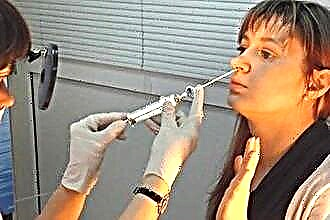Children are much more vulnerable to the effects of many damaging factors than adults - including infectious agents. If a child has a sore throat, this may be a sign of sore throat - inflammation of the palatine tonsils of viral or bacterial etiology.
 After an accurate diagnosis has been established, the question becomes urgent: how to gargle with a sore throat in order to improve the patient's condition and speed up recovery?
After an accurate diagnosis has been established, the question becomes urgent: how to gargle with a sore throat in order to improve the patient's condition and speed up recovery?
Today, rinsing is one of the most popular home procedures for oropharyngeal diseases.
However, drugs that can be used to treat an adult are not always acceptable to give to children. Therefore, it is worth finding out how to rinse a sore throat with angina in children.
How best to treat your throat
In the treatment of children, it is customary to use as many folk remedies as possible. They are traditionally considered the safest and most beneficial. Recipes for rinsing, compresses, tinctures are passed on in some families from generation to generation. A sore throat complaint is a standard “home” indication for starting gargling. How correct is this approach?
First, you need to figure out why you need rinsing at all. Contrary to popular belief, no solution is able to completely clear the throat and, moreover, free the tonsils from pathogenic microorganisms. Although angina is often called any manifestation of inflammation in the oropharynx, this is a specific disease that should be treated in a comprehensive manner, using:
- Systemic therapy (antibiotics).
- Local therapy (tablets for resorption, irrigation with sprays, etc.).
Gargling is a type of topical therapy. Its undoubted advantage is the absence of systemic influence and impact on the affected area. What can be expected from this procedure and what should not be counted on? First of all, tonsillitis (tonsillitis) is a really dangerous bacterial infection. Of course, there are specific types of tonsillitis (for example, infectious mononucleosis, which is of a viral nature), however, beta-hemolytic streptococcus often becomes the causative agent of the mentioned pathology. And rinsing does not pose a serious threat to him if the treatment is carried out without the use of systemic antibacterial drugs.
 At the same time, the procedure allows:
At the same time, the procedure allows:
- moisturize the mucous membrane;
- partially clean the surface of the mucous membrane;
- temporarily reduce the concentration of pathogenic microorganisms.
The effect depends on which rinse aid is chosen.
The frequency of the procedure is also important. The child usually does not like to gargle often, but a single manipulation is not enough.
Choosing a medicine
In the case of streptococcal sore throat, antiseptics are mainly used for local exposure. These are drugs that are capable of destroying pathogenic microorganisms or suppressing their reproduction.
These include:
- Furacilin.
- Hexitidine.
- Biclotymol and others.
The most popular active ingredients, on the basis of which most antiseptic agents are produced, are presented. So, Heksetidine is present in the composition of the drug with the trade name Givalex. Some antiseptics are offered already prepared for rinsing. They are all suitable for home use, but you must first purchase them at the pharmacy. Before starting treatment, it is important to make sure that there is no allergy.
Most antiseptics can only be used from the age of 6.
Since many antiseptic drugs have age restrictions, you should carefully check the instructions and consult your doctor before taking. Some antiseptics (for example, Chlorhexidine) can be toxic, making them undesirable for a small child.
 Antiseptics are also:
Antiseptics are also:
- Hydrogen peroxide;
- preparations including iodine.
In home treatment, these medicines are most commonly used. Their attractiveness is due to their availability (over-the-counter in pharmacies), long shelf life after opening the bottle, and low price. It should also be noted that the rinsing solutions are easy to prepare.
It should not be forgotten that preparations containing iodine are undesirable for use in childhood.
Certain types of iodine-based medicines (for example, Iodinol) are approved for patients over the age of 5 for limited topical use under adult supervision.
Antiseptics for children are prescribed only by the attending physician. They are not drugs that can be used for self-medication. In general, even a suspicion of angina is a good indication for an urgent visit to the pediatrician.
Home medicine
Since the antiseptics recommended by the doctor are used in accordance with the prescriptions received at the appointment, it is advisable to discuss the preparation of those drugs that are often used even before the examination by a specialist. How to gargle with sore throat? The following solutions can be prepared at home:
- Soda.
- Saline.
- Soda-salt.
- Beetroot honey.
- Hydrogen peroxide.
Folk remedies cannot replace the entire therapy as a whole. However, before the pediatrician prescribes treatment for the child, you can try to partially alleviate the condition with home methods. The best moisturizer is saline. In combination with soda, it also acquires moderate (this should not be forgotten) antiseptic properties. Soda is by no means an alternative to antiseptics such as Hexetidine and others.
 For the preparation of solutions, standard dosages are used:
For the preparation of solutions, standard dosages are used:
- water in the amount of 0.2 l;
- salt and / or soda in the amount of a teaspoon.
In the treatment, you can use both kitchen and sea salt without additives - while fine grinding is preferable. Soda and salt solutions are applied up to 10 times a day.
Beet-honey solution is made from freshly grated beet juice, which should be squeezed through cheesecloth beforehand to remove the remaining pulp. A teaspoon of honey is dissolved in warm juice.
For older children, you can add a teaspoon of table vinegar. The dosages are given for the amount of juice 0.2 l.
There is another recipe for beetroot remedy. To prepare it, dissolve a tablespoon of strained beetroot juice, a teaspoon of honey in a glass of warm water. You can add vinegar - the condition and dosage are the same as in the previous method. Beetroot medicine can be used up to 5 times a day.
Peroxide is used only in a diluted form - a 1% solution of the basic substance is suitable for children.
Since pharmacies offer 3% hydrogen peroxide, a three-fold dilution will be required to prepare the solution. This must be taken into account, since different volumes of water can be used (150, 200, 250 ml).
If the child is very young, afraid or cannot understand how to properly gargle, alternative methods of local exposure should be sought. Rinsing can be successfully replaced by drinking plenty of water (water, compotes), lubricating the mucous membrane with drugs. The best option should be discussed with your doctor. The rinsing procedure is far from the only way to eliminate symptoms, so a decision must be made depending on the patient's condition and his mood to use this manipulation.



